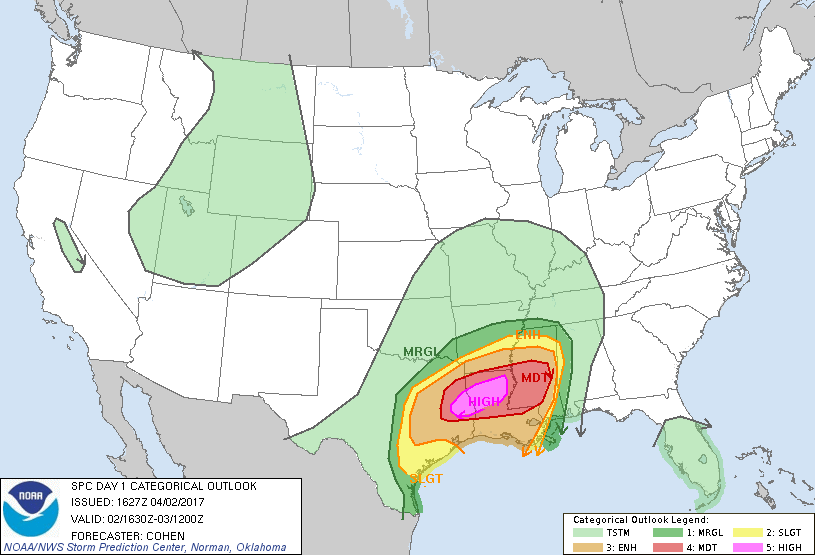Strong thunderstorms erupted on the evening of 04/28/17 and continued into the overnight, expanding in coverage and producing prolific lightning in spots. The Weather Prediction Center’s Metwatch Desk was particularly busy issuing multiple Mesoscale Precipitation Discussions (MPD) to stay ahead of the flash flood threat.

WPC MPD #0150 issued by forecaster, Greg Gallina, at 0015 UTC on 04/28/17. Click to enlarge
NWS Forecaster, Greg Gallina, indicated the following:
“GOES-16/EAST WV LOOP SHOWS A RELATIVELY FLAT
SHORTWAVE ACROSS NW OH WITH THE TRAILING TROF SW ACROSS CENTRAL
IND/IL WITH A MCS TRACKING ACROSS CENTRAL IND. THIS MCS IS AT THE
APEX OF SOUTHWESTERLY LOW LEVEL JET/WAA REGIME OVERRUNNING A WARM
FRONT THAT EXTENDS FROM LWV…N OF LOU AND S OF CVG. THIS COMPLEX
HAS BEEN PRODUCING 1.5-2.5″ RAIN AS IT TRACKED THROUGH WEST
CENTRAL IND…AND WILL LIKELY MAINTAIN AS IT CROSSES INTO LOWER
FFG VALUES ACROSS SE IND/SW OH IN THE NEXT HOUR OR SO.”

GOES-16 6.9 um “mid-level” water vapor animation valid from 1800 UTC – 2357 UTC on 04/28/17. *Preliminary, Non-Operation Data* Click to enlarge
As Greg mentioned, GOES-16 6.9 μm “mid-level” water vapor imagery shows a relatively flat shortwave aiding in the maintenance of the Mesoscale Convective System (MCS) over Indiana and Ohio, while a stronger shortwave can be seen moving out of Iowa into southeastern Minnesota. What other features can you identify in this animation?

GOES-16 1-minute 0.64 um “Red” visible animation valid from 2130 UTC 04/28/17 to 0059 UTC 04/29/17. *Preliminary, Non-Operational Data* Click to enlarge
The GOES-16 1-minute 0.64 μm “Red” visible animation shows the incredible detail in the cloud top environment (0.5 km resolution) of the aforementioned MCS moving through Indiana and Ohio. Note the persistent overshooting tops and their subsequent gravity waves rippling across the cirrus shield. This is indicative of healthy, organized updrafts which a forecaster can then make a decision on whether the activity will persist, strength, or weaken with time.

GOES-16 1-minute 10.3 um “Clean” infrared animation valid from 2130 UTC 04/28/17 to 0259 UTC 04/29/17. *Preliminary, Non-Operational Data* Click to enlarge
Once again, the 1-minute imagery proves valuable here as the trend of the cold cloud tops can be seen expanding with the MCS, while new convection fires near the Illinois, Kentucky, and Indiana borders. Note the dark pixels indicating very cold overshooting tops. Can you spot the enhanced-V structures down-stream from those towers?

WPC MPD #0151 issued by forecaster, Andrew Orrison, at 0300 UTC on 04/29/17. Click to enlarge
As noted by NWS forecaster, Andrew Orrison:
“EXPERIMENTAL GOES-16 IR IMAGERY CONFIRMS THAT
CONVECTIVE INITIATION IS UNDERWAY IN AN ELEVATED FASHION ACROSS
AREAS OF SOUTHERN MO…FAR NORTHWEST AR AND PARTS OF EASTERN OK. A
STRENGTHENING AND VERY MOIST LOW LEVEL JET COUPLED WITH GRADUALLY
IMPROVING RIGHT-ENTRANCE REGION JET DYNAMICS IN VICINITY OF A
WELL-DEFINED QUASI-STATIONARY FRONTAL ZONE SHOULD FACILITATE A
SW/NE AXIS OF STRONG THUNDERSTORMS WITH INTENSE RAINFALL RATES
OVER THE NEXT FEW HOURS.”

GOES-16 CONUS (5-minute) 10.3 um “Clean” infrared imagery with the 5-minute GLD-360 lightning density product overlaid, valid from 2130 UTC 04/28/17 to 0256 UTC 04/29/17. *Preliminary, Non-Operational Data* Click to enlarge
The ongoing MCS in the above GOES-16 10.3 μm “Clean” infrared animation with GLD-360 5-minute lightning density overlaid appears to weaken a bit as new convection farther southwest takes advantage of a stout low-level jet. Notice how the lightning cores are exceeding the color scale that was set by the developers at OPC and NESDIS. Grant it, the color scales are somewhat limited by the GEMPAK software (6.5 bit or 96 colors), yet it’s safe to assume the lightning activity is very intense.

WPC MPD #0154 issued by forecaster, Andrew Orrison, at 0500 UTC on 04/29/17. Click to enlarge
Finally, around 0500 UTC on 04/29/17, Andrew Orrison again referenced GOES-16 in his analysis of the well-defined (new) MCS which developed overnight:
“THE SATELLITE PRESENTATION OF THE CONVECTION IS VERY IMPRESSIVE
WITH THE EXPERIMENTAL GOES-16 10.3 MICRON/IR IMAGERY DEPICTING A
VERY LARGE AREA OF VERY COLD CONVECTIVE CLOUD TOPS…REACHING
NEARLY -80C…WITH NUMEROUS OVERSHOOTING TOPS EMBEDDED WITHIN THE
CONVECTIVE MASS. THIS IS INDICATIVE OF VERY STRONG FORCING WHICH
IS ENHANCED NOT ONLY IN THE LOW LEVELS GIVEN THE LOW LEVEL JET AND
ISENTROPIC ASCENT…BUT ALSO BROADLY DIFFLUENT FLOW ALOFT
ASSOCIATED WITH RIGHT-ENTRANCE REGION JET DYNAMICS.”

GOES-16 CONUS (5-minute) 10.3 um “Clean” infrared animation valid from 2202 UTC 04/28/17 to 0857 UTC 04/29/17. *Preliminary, Non-Operational Data* Click to enlarge
As Andrew referenced in his MPD, as the night progressed, the convection along the Midwest through Ohio Valley erupted into an elongated MCS with embedded Mesoscale Convective Vortices (MCVs) that will have to be watched later in the day.

WPC Day 1-3 QPF issued at 2040 UTC on 04/28/17 and valid from 0000 UTC 04/29/17 to 0000 UTC 05/02/17. Click to enlarge
As you can see in the above Quantitative Precipitation Forecasts for Day 1 (top) and Days 1-3 (bottom), this was only the beginning of a prolonged flood threat for the Mid-Mississippi Valley and eventually farther north to western Michigan.
GOES-16 is certainly proving to be useful in operations as the increased temporal and spatial resolutions when compared to GOES-E (13) and GOES-W (15), provides more detail, fluidity, and trend monitoring to assist in the forecast decision-making process. Additional channels, multispectral imagery (RGBs), band-differences, and derived products will be explored throughout 2017, so please stay tuned for more posts!
Thanks for reading!
































